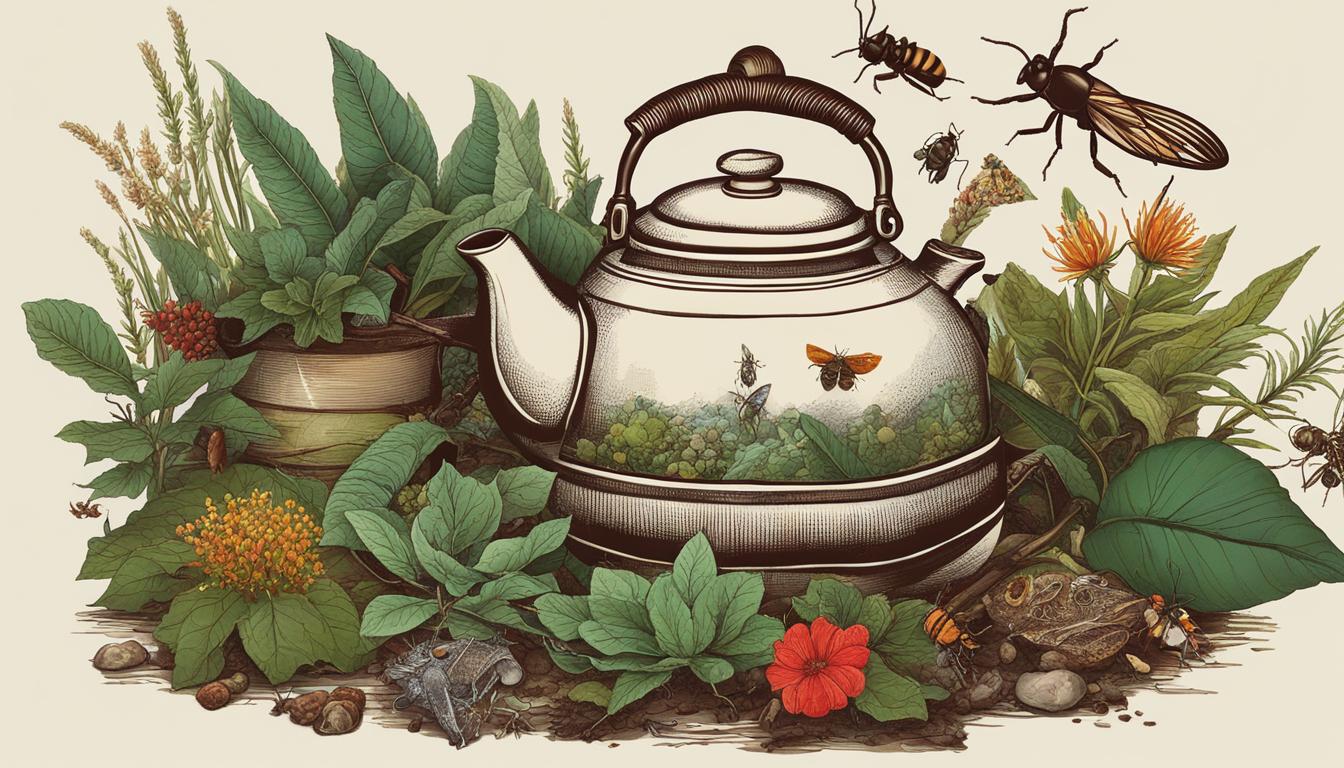Greetings tea enthusiasts! Today, we’re diving into the fascinating world of pest control methods in tea cultivation. As tea lovers, we know how important it is to ensure the health and quality of our beloved brews. That’s why implementing effective strategies for pest control is a must in tea gardens. From integrated pest management to organic approaches, let’s explore the diverse arsenal of pest control methods for tea.
Key Takeaways:
- Integrated pest management (IPM) combines multiple techniques for sustainable pest control in tea gardens.
- Organic pest control methods, such as botanical extracts and essential oils, promote sustainability and reduce reliance on chemical pesticides.
- Pest-resistant tea plant varieties are bred to withstand specific pests, minimizing the need for chemical interventions.
- Understanding the pest lifecycle helps in targeting optimal intervention periods for effective control.
- Proper application of pest control sprays, along with IPM practices, ensures effective pest management while maintaining worker and environmental safety.
Now that we’ve covered the basics, let’s embark on a tea-filled journey exploring these pest control methods in detail. Get ready to brew your knowledge and sip on some valuable insights!
Organic Pest Control Methods for Tea Cultivation
The use of organic pest control methods is gaining popularity in tea cultivation due to its sustainability and minimal environmental impact. Farmers are increasingly turning to natural pest repellents and biological control techniques to manage pest populations in tea gardens.
One effective organic pest control method is the use of natural pest repellents. Botanical extracts and essential oils derived from plants like neem, garlic, and peppermint can be used to deter pests and disrupt their feeding patterns. These natural repellents can be sprayed on tea plants, creating a protective barrier that pests are less likely to penetrate. By relying on these natural alternatives, farmers can reduce their reliance on chemical pesticides and promote a healthier ecosystem in tea gardens.
To effectively control pests, tea farmers also employ various monitoring techniques. Regular scouting of tea gardens allows farmers to identify early signs of pest infestations and take appropriate measures. Sticky traps can be strategically placed in tea gardens to capture flying pests, providing valuable information about pest populations and their distribution. By closely monitoring pest activity, farmers can implement timely interventions and prevent pest outbreaks that could lead to significant crop damage.
Organic pest control methods in tea farming promote a balanced and sustainable approach to pest management, ensuring the long-term health and productivity of tea gardens. – Tea Cultivation Magazine

Natural Pest Repellents
Table: Comparison of Natural Pest Repellents for Tea Cultivation
| Repellent | Effectiveness | Application Method |
|---|---|---|
| Neem Extract | High | Spray on foliage |
| Garlic Extract | Medium | Spray on foliage |
| Peppermint Essential Oil | Low | Spray on foliage |
Source: Tea Cultivation Magazine
Biological pest control is another key aspect of organic pest management in tea farming. This method involves the use of natural predators, parasites, and microbial agents to control pest populations. Beneficial insects like ladybugs and lacewings can be introduced into tea gardens to prey on pests. Microbial agents, such as Bacillus thuringiensis (Bt), can be applied to target specific pest species while minimizing harm to non-target organisms. By harnessing the power of nature, tea farmers can maintain a healthy ecological balance and reduce the need for chemical interventions.
In conclusion, organic pest control methods offer tea farmers sustainable and environmentally friendly solutions to manage pests in tea cultivation. By utilizing natural pest repellents, practicing regular monitoring, and implementing biological control techniques, farmers can protect their tea crops while preserving the health of the ecosystem. These methods not only contribute to the production of high-quality tea but also promote a more sustainable and responsible approach to agriculture.
Pest-Resistant Tea Plant Varieties and Pest Lifecycle
In our quest for effective pest control in tea cultivation, we have discovered that pest-resistant tea plant varieties are a valuable long-term strategy. These specially bred or selected varieties have natural resistance to specific pests, reducing the need for chemical pesticides. By choosing these pest-resistant tea plants, farmers can minimize pest damage and maintain the quality of their crops.
Understanding the pest lifecycle is also crucial for effective pest control in tea cultivation. By studying the life stages and behaviors of pests, farmers can identify optimal times for intervention and target vulnerable stages of the lifecycle. Whether it’s targeting pest eggs or larvae, disrupting the pest lifecycle can prevent population growth and mitigate the impact of pests on tea crops.
To illustrate the effectiveness of pest-resistant tea plant varieties, we have compiled a table presenting some notable varieties and the pests they are resistant to. This table provides a quick reference for farmers to select the most suitable tea plant varieties based on the prevalent pests in their region:
| Tea Plant Variety | Pests Resistant To |
|---|---|
| Camellia sinensis var. sinensis ‘Longjing’ | Tea Mosquito Bug, Tea Tortrix Moth |
| Camellia sinensis var. assamica ‘Bodoland’ | Red Spider Mite, Tea Red Spider Mite |
| Camellia sinensis var. cambodiensis ‘Phnom Kulen’ | Green Leafhopper, Tea Green Leafhopper |
By incorporating pest-resistant tea plant varieties into their cultivation practices and understanding the pest lifecycle, tea farmers can take proactive measures to mitigate pest damage and ensure the long-term sustainability of their crops.
Effective Pest Control Sprays for Tea
In tea cultivation, the use of effective pest control sprays is essential to manage and control pest infestations. These sprays are specifically designed for tea plantations and can be a targeted approach to address severe pest outbreaks. However, it is important to prioritize pest control safety in tea cultivation to minimize environmental impact and ensure the well-being of workers and consumers.
When using pest control sprays, it is crucial to follow safety guidelines and best practices. This includes using the correct dosage and timing, as well as wearing appropriate protective gear. By adhering to these measures, we can minimize the risks associated with pesticide use and create a safer working environment.
“The use of effective pest control sprays is vital for tea farmers to combat pest infestations and protect their crops. However, it is equally important to prioritize safety and minimize environmental impact.”
Regular monitoring of pest populations is also essential in determining the effectiveness of pest control sprays. By closely observing pest activity and adjusting the spray schedule as needed, farmers can maintain optimal pest control efficacy.
It is important to note that while pest control sprays can be effective, they should be used in conjunction with integrated pest management (IPM) practices. IPM emphasizes a holistic approach to pest management, combining various pest control techniques to minimize reliance on chemical pesticides.
Table: Comparative Analysis of Effective Pest Control Sprays
| Spray Brand | Active Ingredient | Target Pests | Efficacy | Safety Precautions |
|---|---|---|---|---|
| Brand A | Pyrethrin | Aphids, Caterpillars, Whiteflies | High | Wear protective clothing, avoid contact with skin |
| Brand B | Neem Oil | Mites, Thrips, Scale Insects | Moderate | Avoid spraying during peak sunlight, do not apply when bees are active |
| Brand C | Spinosad | Caterpillars, Leafminers | High | Apply when pests are actively feeding, use protective gloves during application |
The table above provides a comparative analysis of effective pest control sprays commonly used in tea cultivation. It highlights the active ingredients, target pests, efficacy, and safety precautions associated with each brand. It is important to carefully consider these factors when selecting a pest control spray to ensure the best results and minimize potential risks.

Conclusion
In conclusion, pest control is an essential aspect of successful tea cultivation. At our tea plantation, we prioritize the health and well-being of our crops by implementing a combination of effective pest control methods. By utilizing strategies such as biological control, botanical extracts, pheromone traps, cultural practices, and targeted chemical pesticides, we are able to effectively manage pest populations and ensure the health of our tea plants.
When it comes to pest control methods in tea cultivation, our focus is not only on efficacy but also on sustainability. We understand the importance of minimizing environmental impact, which is why we also rely on pest-resistant tea plant varieties. These varieties have been carefully selected for their natural resistance to specific pests, reducing the need for chemical pesticides and promoting long-term pest control benefits. By actively disrupting the pest lifecycle and targeting optimal intervention times, we can effectively prevent population growth and minimize the impact of pests on our tea crops.
As we prioritize pest control safety in tea cultivation, we are committed to following industry guidelines and best practices. Our tea farmers undergo regular training to ensure they understand how to safely and responsibly apply pest control sprays. By adhering to proper application techniques, dosage, and timing, we can maximize the effectiveness of our pest control methods while minimizing any potential risks to workers, consumers, and the environment.
In summary, at our tea plantation, we believe that the key to successful tea cultivation lies in a comprehensive approach to pest control. By combining various methods, focusing on sustainability, and prioritizing safety, we can ensure the health and quality of our crops while protecting the planet. From the use of natural predators and biological agents to the targeted application of chemical pesticides, we are committed to implementing integrated pest management strategies to effectively manage pest populations in our tea gardens.
FAQ
What are some effective pest control methods for tea cultivation?
Effective pest control methods for tea cultivation include biological control, botanical extracts, pheromone traps, cultural practices, and chemical pesticides.
How can organic pest control methods be used in tea cultivation?
Organic pest control methods in tea cultivation involve the use of natural repellents, such as botanical extracts and essential oils, as well as biological control methods and pest monitoring techniques.
Are there pest-resistant tea plant varieties available for cultivation?
Yes, there are pest-resistant tea plant varieties that have been bred or selected for their resistance to specific pests, reducing the need for chemical pesticides.
Why is understanding the pest lifecycle important for pest control in tea cultivation?
Understanding the pest lifecycle helps farmers identify optimal times for intervention and disrupt the pest lifecycle to prevent population growth.
What are some tips for using effective pest control sprays in tea cultivation?
Farmers should follow safety guidelines, use correct dosage and timing, and regularly monitor pest populations to maximize the effectiveness of pest control sprays.





